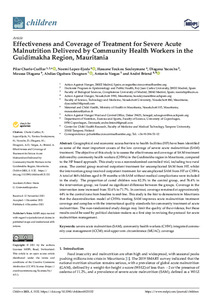Effectiveness and coverage of treatment for severe acute malnutrition delivered by community health workers in the Guidimakha region, Mauritania
Charle-Cuéllar, Pilar; Lopez-Ejeda, Noemí; Souleymane, Hassane Toukou; Yacouba, Diagana; Diagana, Moussa; Dougnon, Abdias Ogobara; Vargas, Antonio; Briend, André (2021-12)
Charle-Cuéllar, Pilar
Lopez-Ejeda, Noemí
Souleymane, Hassane Toukou
Yacouba, Diagana
Diagana, Moussa
Dougnon, Abdias Ogobara
Vargas, Antonio
Briend, André
12 / 2021
1132
Julkaisun pysyvä osoite on
https://urn.fi/URN:NBN:fi:tuni-202201101206
https://urn.fi/URN:NBN:fi:tuni-202201101206
Kuvaus
Peer reviewed
Tiivistelmä
Geographical and economic access barriers to health facilities (HF) have been identified as some of the most important causes of the low coverage of severe acute malnutrition (SAM) treatment. The objective of this study is to assess the effectiveness and coverage of SAM treatment delivered by community health workers (CHWs) in the Guidimakha region in Mauritania, compared to the HF based approach. This study was a nonrandomized controlled trial, including two rural areas. The control group received outpatient treatment for uncomplicated SAM from HF, whilst the intervention group received outpatient treatment for uncomplicated SAM from HF or CHWs. A total of 869 children aged 6–59 months with SAM without medical complications were included in the study. The proportion of cured children was 82.3% in the control group, and 76.4% in the intervention group, we found no significant difference between the groups. Coverage in the intervention zone increased from 53.6% to 71.7%. In contrast, coverage remained at approximately 44% in the control zone from baseline to end-line. This study is the first to demonstrate in Mauritania that the decentralization model of CHWs treating SAM improves acute malnutrition treatment coverage and complies with the international quality standards for community treatment of acute malnutrition. The non-randomized study design may limit the quality of the evidence, but these results could be used by political decision-makers as a first step in revising the protocol for acute malnutrition management.
Kokoelmat
- TUNICRIS-julkaisut [16951]
